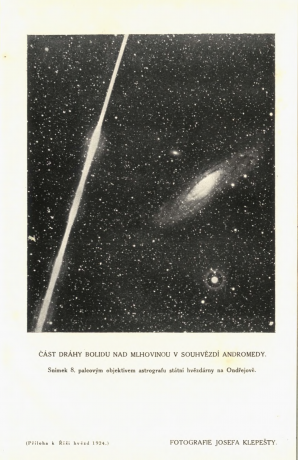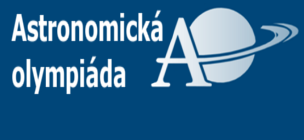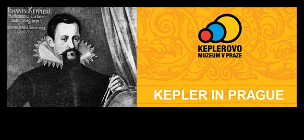Josef Klepešta: Fireball in Andromeda

Autor: Josef Klepešta, Říše hvězd (Realm of the Stars)
On the night of September 12-13, 1923, the 28-year-old Josef Klepešta took a four-hour exposition on the glass plate with an astrograph of the Ondřejov observatory (20 cm anastigmat, 95 cm focus) of M31 in the Andromeda constellation. During the exposition, a fireball flew through the field of view, leaving a clear mark and thus creating his famous photograph. We present two original Klepešta contributions published in the Říše hvězd (Realm of the Stars) magazine.
English version of the Czech article (česká verze) was translated in May 2019.
Josef Klepešta wrote for the Říše hvězd (Realm of the Stars), Volume IV, Issue 5 September-October on page 171, "Perseid Observation in August 1923". Below this article, he was able to add an addendum on the currently photographed fireball, which we present here.

Autor: Josef Klepešta, Říše hvězd (Realm of the Stars)
A m e n d m e n t: Big fireball was spotted on 12 September 1923 at 22h 55m and about 23s flying northeast from the constellation Pegasus to the constellation Andromeda, where it ruptured close to the star A. The apparent diameter of the fireball at the end of its path was about 20'; the light was so bright, that it illuminated machine parts in the dark dome. The burst was manifested by numerous flare ups; however, there was no detonation. A part of the fireball path with explosions above the Andromeda Nebula was captured by an 8-inch lens of the astrograph in Ondřejov. This interesting photo will be published in one of the next issues of Ř. h.
Immediately in the first issue of Říše hvězd (Realm of the Stars) 1924/1, the article Photo of the fireball was published on page 11.
Photo of fireball. On September 12 this year, an unusually bright fireball flew northeast of the constellation Pegasus to Andromeda. It moved slowly and its brightness was constantly increasing. It was followed by the glowing dust above the Andromeda Nebula, near star A Andromedae, where it tore. The burst was manifested by numerous flare ups and a strong flash, which lightened the landscape. The apparent diameter of the appearance at burst time was at least 20 '. There was no detonation. On the same evening, I chose surroundings of the Andromeda nebula as a target for the 8-inch anastigmat of the astrograph of the Ondrejov observatory and began exposition at 20h45m. The size of the used 9x12 cm sensitive glass plate was enough to cover an area of about 5x7° in the sky, so that only part of the path of the fireball could be captured. Four separate bursts are clearly marked in the image (see appendix to this issue). It is also possible to see the trace widening in the north-east direction until a sphere is formed (outside the lens field). Its subsequent explosion ends the fireball visibility. I watched the beautiful appearance just by chance, glanced at that moment from the pointer to the sky. Recording time and other data, I continued uninterrupted up to 0h45m in the exposition of the large Andromeda Nebula.
In the first double issue of the Říše hvězd (Realm of the Stars) of 1924 January-February, in addition to the article, there was inserted an attachment with a photograph of Josef Klepešta with this description: THE PART OF THE PATH OF THE FIREBALL ABOVE NEBULA IN THE ANDROMEDA CONSTELLATION. Shot by the 8-inch astrograph lens of the Ondřejov Observatory.

Autor: Josef Klepešta, Říše hvězd (Realm of the Stars)
It is a worth noting, that the photo label speaks about the nebula. After all, in 1922 and 1923, Edvin Hubble was only completing his discovery observations of the cepheids in the M31 and M33 nebulae at the largest 2.5-meter telescope and proving that they were not nebulae but galaxies. He published his discoveries in an article in The New York Times on November 23, 1924.
The fireball was also watched by Vladimír Guth in 34 km distant Černošice. In the first double issue of the Říše hvězd (Realm of the Stars) in 1924, in addition to the photography, he published his own article on the calculation of the meteor's path, including a preliminary parabolic orbit.
Five years after founding of the Czech Astronomical Society, Klepešta's photography inspired many astronomers and visitors to observatories and became an essential part of the Czech astronomy. For example, in an ESO publication published on the occasion of the Czech Republic's accession to the European Southern Observatory, it occupies a prime place next to the Prague Astronomical Clock and the Clementinum.
Thanks to SUPRA Praha, spol.s.r.o., which is providing on it's website digital archive of the magazine Říše hvězd (Realm of the Stars). The text of the article is based on OCR text from this archive.
Zdroje a doporučené odkazy:
[1] Říše hvězd (Real of the Stars) 1923/5 September-October
[2] Říše hvězd (Real of the Stars) 1924/1 January-February
[3] Hubble s Announcement of Cepheids in Spiral Nebulae
[4] Cyril Polášek: Zpráva o konání skromné vzpomínky (Report about holding modest memory), IAN
[5] Cyril Polášek: Druhá zpráva o konání skromné vzpomínky (The second report about holding modest memory), IAN
[6] Astronomy in the Czech Republic: ESO - The Messenger 128 – June 2007, page 4
[7] Vladimír Guth: Výpočet dráhy meteoru (Calculation of the meteor path)
[8] Vladimír Guth: První fotografie meteorů (The first photographs of meteors)






